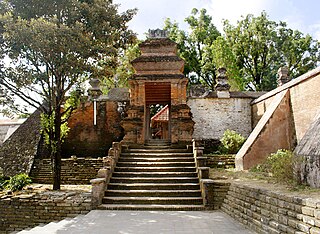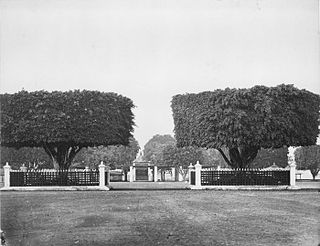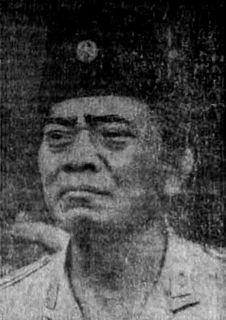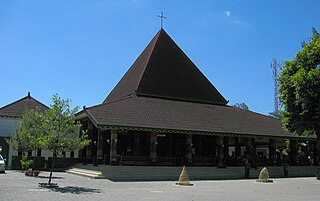
Bintaran is a village in Wirogunan, Mergangsan, Yogyakarta, Indonesia. The area is known for its Dutch-Javanese architecture. It was formerly a Catholic settlement.

Bintaran is a village in Wirogunan, Mergangsan, Yogyakarta, Indonesia. The area is known for its Dutch-Javanese architecture. It was formerly a Catholic settlement.

Before evolving into an Indisch settlement, Bintaran was known as the location of Ndalem Mandara Giri, a palace of Prince Haryo Bintoro, one of the descendant of Ngayogyakarta Hadiningrat. The name Bintaran is derived from the name of the prince. During the 1930s, the location grows as an Indisch settlement when a church and civic buildings were constructed. At that time, Bintaran was an alternative settlement region for the Dutch people in Yogyakarta which evolved after Loji Kecil area was not adequate anymore. Dutch people who resided in Bintaran were usually officers or sugar factory workers. [1]
Buildings in Bintaran are fusion of Javanese-Dutch style with thick white walls, tall main door and tall windows. The area has a distinct style which makes it different with buildings in Loji Kecil or Kota Baru: the yard are more spacious while the porch smaller with many pillars. The front doors are usually louvered and the inner doors are often completed with glass. [1]
One of the oldest building is Ndalem Mandara Giri, the former palace of the Prince. The building shows fusion between Dutch and Javanese architecture in the use of Javanese pendopo element, specially constructed with building material from Demak in 1908; and a Dutch-styled interior with a typical high ceiling and tall windows. The house functioned as exhibition room for kris.
Sudirman Museum or officially Museum Sasmitaloka Panglima Besar (Pangsar) Jenderal Sudirman is a museum building on the left side of Bintaran Road. The building was completed in 1890 and was used as residence for financial officer of Pura Paku Alaman VII named Wijnschenk. During the course of history, this building was also used as the residence of General Sudirman.
The Biology Museum of Bintaran is located at Jalan Sultan Agung. It was utilized as the residence of Pakualaman military supervisor. The Fire Fighters Quarter of Bintaran was formerly the residence of Henry Paul Sagers. Wirogunan prison is a Dutch prison which is still used today. [2]

The church of Bintaran was founded by H. van Driessche to accommodate the increasing amount of Catholics in Yogyakarta as Kidul Loji Church could not accommodate them anymore. It was designed by J.H. van Oten BNA and the construction was executed by Hollandsche Beton Maatschappij in 1931 on the Kampementstraat (now Bintaran Kidul). [3] The church was designed by Father H. Van Driessche and Mr. Dawoed specifically for the Javanese people, as Javanese people at that time were not used to attend religious ritual in a Western-style building (e.g. sitting on bench, long narrow room) because of the fabric they used. St. Joseph Church of Bintaran is 36 meters by 20 meters long, and the height is 13 meters. The church is white following the color of the surrounding buildings. The mass bench is only located at the back side, where the Europeans and Javanese upper class usually sat. The front part of this are mattress made of bamboo for the Javanese mass service to sit upon. Sun light enters the room through 72 double roosters instead of windows. [4]

Batu, officially the City of Batu, is a landlocked city in the East Java Province of Indonesia. It is about 20 km to the northwest of Malang. Formerly, it was a part of Malang Regency; but in 2001, Batu became an independent city legalized by Act No. 11 of 2001, when it became an independent municipal city with its own mayor and council.

Prince Diponegoro, also known as Dipanegara, was a Javanese prince who opposed the Dutch colonial rule. The eldest son of the Yogyakartan Sultan Hamengkubuwono III, he played an important role in the Java War between 1825 and 1830. After his defeat and capture, he was exiled to Makassar, where he died, 69 years old.

Sultan Anyakrakusuma is known as Sultan Agung was the third Sultan of Mataram in Central Java ruling from 1613 to 1645. A skilled soldier he conquered neighbouring states and expanded and consolidated his kingdom to its greatest territorial and military power.

Kotagede is a historic neighborhood in Yogyakarta, Indonesia. The name was also used for the district (kemantren) of the same name in the City of Yogyakarta. Kotagede contains the remains of the first capital of Mataram Sultanate, established in the 16th century. Some of the remains of the old Kotagede are remains of the palace, the royal cemetery, the royal mosque, and defensive walls and moats. Kotagede is well known internationally by its silver crafting.

Yogyakarta is the capital city of Special Region of Yogyakarta in Indonesia, in the south-central part of the island of Java. As the only Indonesian royal city still ruled by a monarchy, Yogyakarta is regarded as an important centre for classical Javanese fine arts and culture such as ballet, batik textiles, drama, literature, music, poetry, silversmithing, visual arts, and wayang puppetry. Renowned as a centre of Indonesian education, Yogyakarta is home to a large student population and dozens of schools and universities, including Gadjah Mada University, the country's largest institute of higher education and one of its most prestigious.

Amangkurat II was the Susuhunan of Mataram from 1677 to 1703. Prior to taking the throne, he was the crown prince and had the title Pangeran Adipati Anom.

The architecture of Indonesia reflects the diversity of cultural, historical and geographic influences that have shaped Indonesia as a whole. Invaders, colonizers, missionaries, merchants and traders brought cultural changes that had a profound effect on building styles and techniques.

Plered was the location of the palace of Amangkurat I of Mataram (1645–1677). Amangkurat moved the capital there from the nearby Karta in 1647. During the Trunajaya rebellion, the capital was occupied and sacked by the rebels, and Amangkurat died during the retreat from the capital. His son and successor Amangkurat II later moved the capital to Kartasura. It was twice occupied by Diponegoro, during the Java War (1825–1830) between his forces and the Dutch. The Dutch assaulted the walled complex in June 1826, which was Diponegoro's first major defeat in the war.

The Kraton Ngayogyakarta Hadiningrat is a palace complex in the city of Yogyakarta, Yogyakarta Special Region, Indonesia. It is the seat of the reigning Sultan of Yogyakarta and his family. The complex is a center of Javanese culture, and contains a museum displaying royal artifacts. It is guarded by the Yogyakarta Kraton Guards.

An alun-alun is a large, central, open lawn square common to villages, towns and cities in Indonesia.

Taman Sari Water Castle, also known as Taman Sari, is the site of a former royal garden of the Sultanate of Yogyakarta. It is located about 2 km south within the grounds of the Kraton, Yogyakarta, Indonesia. Built in the mid-18th century, the Taman Sari had multiple functions, such as a resting area, a workshop, a meditation area, a defense area, and a hiding place.

A landhuis is a Dutch colonial country house, often the administrative heart of a particuliere land or private domain in the Dutch East Indies, now Indonesia. Many country houses were built by the Dutch in other colonial settlements, such as Galle, Cape Town and Curaçao, but none as extensively or elaborately as in the Residency of Batavia. Much of Batavia's reputation as "Queen of the East" rested on the grandeur of these 18th-century mansions.

Surakarta Sunanate was a Javanese monarchy centred in the city of Surakarta, in the province of Central Java, Indonesia.

Oerip Soemohardjo was an Indonesian general and the first chief of staff of the Indonesian National Armed Forces. He received several awards from the Indonesian government, including the title National Hero of Indonesia in 1964. He was also a recognized Catholic by the Holy See, by which Pope Paul VI dedicated a memorial chalice for him with a Latin inscription acknowledging his legacy.

Albertus Soegijapranata, SJ, better known by his birth name Soegija, was a Jesuit priest who became the Apostolic Vicar of Semarang and later its archbishop. He was the first native Indonesian bishop and known for his pro-nationalistic stance, often expressed as "100% Catholic 100% Indonesian".

The Church of the Sacred Heart of Jesus, also known as the Ganjuran Church, is a Roman Catholic church located in Ganjuran, Bantul, Java, Indonesia. It is the oldest church in its administrative regency.
Sasana Wiratama, also known as Museum Monumen Pangeran Diponegoro is a museum complex in Yogyakarta, Indonesia. The complex consists of a museum and a monument which commemorates the struggle of Prince Diponegoro, an 18th-century Javanese prince and a National Hero.
Royal Ambarrukmo is a luxury hotel located in Sleman Regency, Yogyakarta, Indonesia. The hotel was built as directed by Indonesian President Sukarno in 1964, alongside Jakarta's Hotel Indonesia, Pelabuhan Ratu's Hotel Samudera, and Bali's Bali Beach Hotel. The hotel was built on the site of the former Ambarrukmo Palace, a 19th century royal residence of the Yogyakarta Sultanate, from which the hotel derives its name. The buildings of the former palace still stands and is now housed within the hotel compound.
| Wikimedia Commons has media related to Bintaran . |